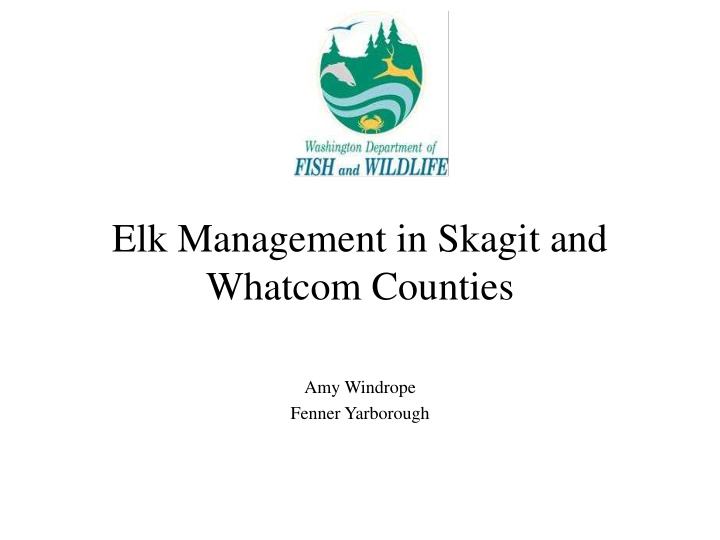



Elk Management in Skagit and Whatcom Counties Amy Windrope Fenner Yarborough
North Cascades elk herd • Commonly referred to as Nooksack elk herd • Current population of survey area~ 1,500 • Population objective 1,700-2,000 • Co-managed with Point Elliott Treaty Tribes
Elk have used the Skagit Valley since time immemorial and we have helped • 1912 – 46 elk from Montana • 1946 – 9 from King County, 6 from Yakima • 1948 – 8 from Yakima County • 2003 – 43 from Mt. St. Helens • 2004 – 4 from Mt. St. Helens • 2005 – 51 from Mt. St. Helens
Herd management history • Declined from a high of 1,400 – 2,000 in 1984 to only a few hundred in late 1990’s • Harvest moratorium 1997-2006 • Population augmentations • Current population is expanding
Elk Damage Information Jan 1 – Dec 31 Skagit Elk Total of all Total Total Number Total Number Total Number of Total Number of Damage Commercial of Complaints of Claims Kill Permits and Elk Harvested by Year Complaints Producer Eligible for Claim Submitted by Damage Landowners Complaints Producer to Prevention WDFW Permits Issued to Landowners 2015 48 19 1 1 30 25 2016 64 24 2 0 40 24 2017 78 31 2 0 52 34 2018 63 23 1 0 66 30 2019-YTD 23 14 0 - - -
Elk Related Agricultural Conflicts • 2013 – present – managed by Conflict Program • 2015 - 2018 – # of damage permits increased each year • 2018 – 66 permits issues with landowner harvest of 30
What is happening in the community
Recent Efforts • Increased community and stakeholder involvement and communication about elk management, conservation, ecological sustainability, and social tolerance • WDFW provided 85,794 linear feet of fencing materials to participating landowners • Increased Co-manager discussions regarding damage issues
2019-2020 Action Plan • Issue damage permits pre- emptively to qualifying landowners • Revised compensation forms and Damage Prevention Cooperative Agreement process • Landowner access fees • Hoof disease removals • Discussions with WDOT on signage, speed limits, outreach, etc. • Mapping tools - Swinomish • Targeted neighborhood management
Targeted Neighborhood Management • Identify resident elk groups in agricultural areas • Increased pressure • Non-lethal techniques • DPCA’s and access across multiple properties • Landowner permission and cooperation in neighborhood efforts • Tribal participation
2019-2020 Metrics • Reduce number of elk damage complaints from 2018 levels in designated neighborhoods • Majority of damage harvest occurs in targeted neighborhoods • Increase number of requests to Tribes to participate in neighborhood hazing or harvest • Respond to limping elk reports within 7 days with timely removal if TAHD is suspected (per protocol) • Increase outreach and include collision report phone number in all press articles
Recommend
More recommend